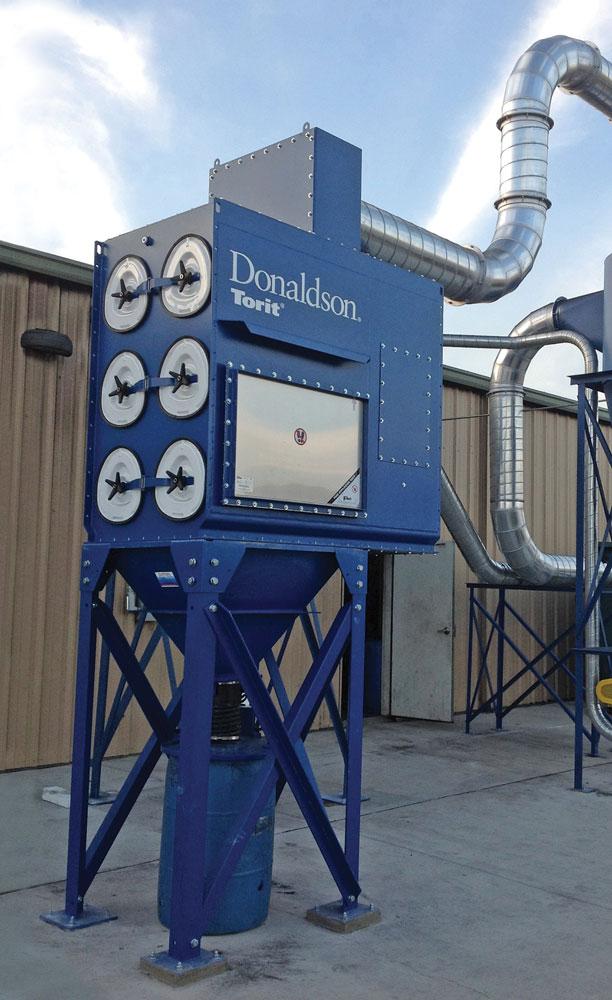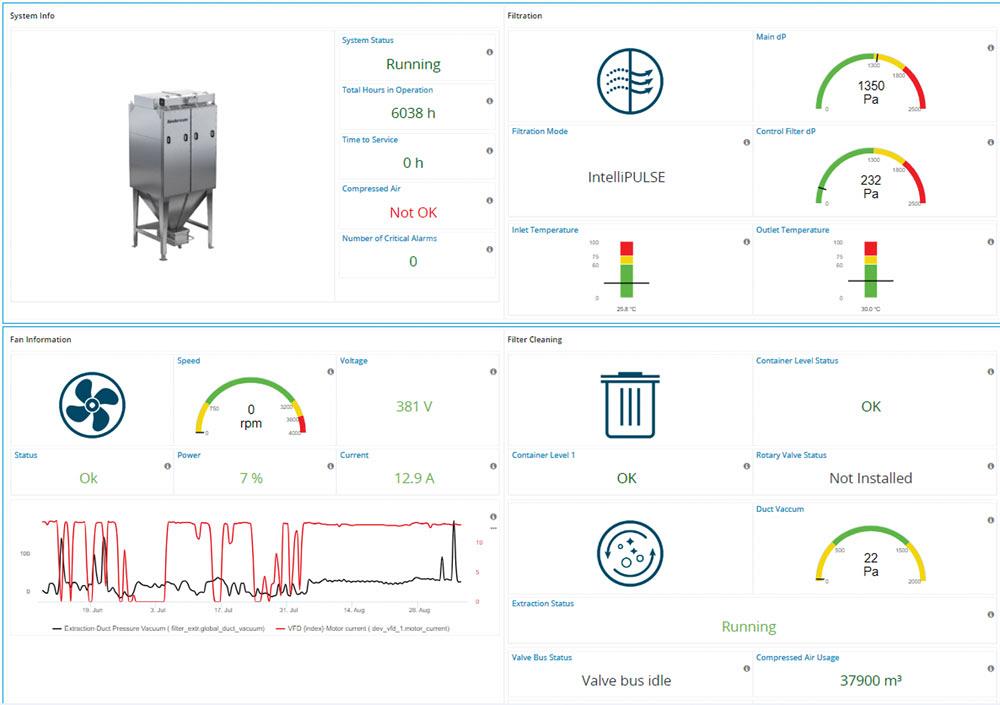Associate Editor
- FMA
- The Fabricator
- FABTECH
- Canadian Metalworking
6 steps to limit air contaminants in the job shop
Best practices help fabricators target a system that aligns with their budget, operational flow, and employee needs
- By Lindsay Luminoso
- November 29, 2023
- Article
- Automation and Software

There are different methods to collecting general air concentration, but experts agree that collecting a contaminant at the source is almost always the best option. Nederman
If the last few years have taught us anything, it’s that what we breath in can hugely affect both our health and well-being. There is no doubt that the airborne virus that rocked the world forced many businesses to rethink the flow of operations, safety mechanisms, and employee risk. And while the hypervigilance of the past few years has waned, many shops have kept good practices in place.
Today’s job shops have to contend with higher operational costs, evolving regulations, and employee retention issues. However, one thing that has remained constant is the need to protect employees from daily exposure to common risks associated with various manufacturing processes.
One of the biggest concerns is the long-term exposure to any particulate suspended in the air. This could include airborne dust, smoke, fumes, or even oil mist. Fabrication shops tend to have both dry contaminants, from grinding and welding, and sticky contaminants, from oil mists and other lubrication needs.
Over time, exposure to different airborne contaminants can lead to various health issues, many of which are still unknown. Some materials have obvious links to cancer, but many of the other effects may or may not be severe but can still impact overall quality of life.
Recent studies have shown that regular exposure to airborne toxins reduces cognitive ability, overall productivity, and the immune system’s ability to fight off disease. So not only is there a long-term risk to exposure, but there is a day-to-day risk associated as well.
Here are some steps fabricators can take to mitigate risks.
1. Identify Source of Hazards
The first step is to identify the source of any hazards on the shop floor. Look at your processes and materials.
“For example, with welding, it is obvious that contaminants will come from the welding torch and the base metal you are welding with,” said Travis Haynam, vice-president segments, extraction and filtration division at Nederman, Charlotte, N.C. “Once you’ve identified a source, if you can eliminate it, do it. If you can’t, then you need to explore engineering controls to manage it. This can take a lot of shapes and forms.”
There are some commonly known hazards such as the exposure to hexavalent chromium when working with stainless steel. However, more and more hazards are coming to light.
“For instance, in the last few years, manganese has become more common,” said Chrissy Klocker, senior manager engineering, industrial air filtration at Donaldson, Minneapolis. “However, manganese is a substance to use with care. Fabricators need to know exactly what they are dealing with as there can be subcomponents and subsets of hazards found in associated aspects of the manufacturing process. It is important to check all of the substances found in your materials to understand the risks and how to eliminate or address them.”

With so many options available, it’s important for fabricators to choose an equipment manufacturer that understands daily challenges, needs, and operations. That information can help them guide the fabricator toward the right technology. Donaldson
2. Work With an Expert
One of the only ways a fabricator can know if it is within the exposure limit regulations is to hire an industrial hygienist.
There are a few different readings a hygienist can take. The first is most likely going to be a general contaminant reading, which analyzes the facility’s dust and general atmosphere.
“Seeing haze or dust concentrating in the air, indicates you have contaminant, but it may be within acceptable levels depending on what it is,” said Klocker.
The second test gauges the personal breathing zone of individual employees.
“This is especially true if you are dealing with toxic materials,” said Haynam. “A hygienist can come in and put sensors on workers and measure exactly what each individual is exposed to throughout the day. This will let you know where you sit in terms of compliance.”
Getting a baseline is a great place to start. For fabricators that are within the limits, there is no request for further testing unless conditions change. However, if a fabricator is above the limit, controls need to be put in place.
“If you cannot eliminate a risk, look at controls to adequately manage it,” said Klocker. “The control could be installing industrial ventilation systems, using PPE like a PAPR, or even moving employees around on the shop floor to ensure that they are not over exposed to the hazard. If that control gets you into compliance, great, if not, additional changes will have to be made.”
An industrial hygienist will be able to measure accurately and effectively for different hazards and they will know the exposure limits for specific components.
3. Understand Regulatory Requirements
Many fabricators may not be aware of all the guidance and regulatory requirements, which is why an industrial hygienist can help. But there is a lot of information available to give fabricators a head start.
In Canada, there are fourteen jurisdictions—one federal, ten provincial, and three territorial—and each has its own occupational health and safety (OHS) legislation. Fabricators can reach out to their provincial and territorial governments to understand exposure limit requirements within their jurisdiction. Canadian Centre for Occupational Health and Safety (CCOHS) also provides information to direct fabricators to regulatory requirements.

Economical technology is available to measure various aspects of an air filtration system, like when filters need to be changed. That technology also can be used to adjust airflow to achieve proper capture when it senses filter issues.Nederman
“Many fabricators are at a loss as to exactly what they need to do,” said Haynam. “Especially small to medium shops, who don’t necessarily have an EHS department to turn to, especially with changing regulations. There are so many options available to fabricators to help get them under the limits, but how will they know if one filter can be used for hexavalent chromium or if combustible dust collectors need to be moved outside. There are a lot of questions that industrial hygienists or equipment suppliers can help with.”
Stream extraction, source capture, and ambient systems all can help, but they don’t necessarily perform in the same way. All of them can be used to effectively achieve compliance depending on the situation. It’s also important to understand how trends are changing over time and in different jurisdictions.
“We are now seeing some European countries change their guidance on weld fume collection after the International Agency for Research on Cancer classified weld fume as a known carcinogen in 2018,” said Klocker. “This change may lead fabricators to consider different technologies or strategies for filtering weld fume. In the US, we are starting to see non-regulatory groups, like the American Conference of Governmental Industrial Hygienists, amend their guidelines related to weld fume hazards.”
There have been a lot of changes to manufacturing, and the technology available paired with shifting health and safety trends are affecting that. There tends to be a lot of stakeholders involved beyond the standard health and safety agencies, including environmental, waste disposal, and fire protection regulations that all have to be taken into account for a full-picture view.
4. Explore Option Limitations
There are a lot of considerations to take into account when investing in controls and technology to mitigate hazards. It can be as simple as natural ventilation, where a garage door is opened at the beginning of a shift, to an advanced industrial air filtration system.
“Key considerations include: What material are you working with,” said Klocker. “What are the hours of operation or duty cycle? Is it continuous operations? Do you want to return air back into the building or exhaust it outside? For example, if a small shop is spending a lot of money to heat their facility in the winter, they may want to return the air back into the facility rather than risk having an increase in their energy bill. Sometimes adding these systems will require changes to other heating and cooling systems. You want to make sure you’re really picking the right technology, the right size, and the right decisions for that end user.”
Smaller shops are going to have different needs than large manufacturers, and there may be limitations related to available human and financial resources.
“There is no one-size-fits-all approach,” said Haynam. “There are a lot of bells and whistles that may not add any value to a system. You need to find something that works for you, your budget, operational flow, and employee needs. There are some very effective options that focus on safety that don’t require hundreds of thousands of dollars to put in place.”
There are different methods to collecting general air concentration, but the experts agree the capturing a contaminant at the source is almost always the best option. That may include installing a ducted system with a hood which collects the air up and away from the source, filters it out, and returns it back into the building.
Haynam noted that on-torch fume extraction is gaining in popularity thanks to improved ergonomics and performance. Another important tool or approach for fabricators is automation like cobots and how they can be integrated into an overall strategy in areas where human workers/welders are exposed to unsafe air quality.

There are different ways that fabricators can put controls in place. But those controls need to work for the employees, the process, and the budget. Donaldson
“There are some ambient systems out there, but they are only good at moving and collecting ambient dust within a room,” said Klocker. “If the hazard has to do with employee exposure, these types of systems alone are not adequate. You may be able to pair them with PPE like a PAPR device, a ducted system, or some sort of belt and suspenders approach rather than solely relying on ambient collection.”
PPE and PAPR have their place but are a last resort according to the hierarchy of controls. According to Haynam, on-torch fume extraction paired with ambient collection is a preferred approach versus PAPR when allowed.
5. Consult Operators
Every shop’s needs are going to be different depending on the hazards and the preferences of shop floor workers. That’s why a one-size-fits-all approach doesn’t exist.
“While safety is the most important feature of these systems, they also need to match the process, and workers need to be comfortable using them,” said Haynam. “One of the worst things you can do is invest all this money and effort putting in a new extraction system that workers won’t use, or the equipment wasn’t designed to work with the geometry of the workpiece, or it doesn’t get close enough to the process to be effective.”
Some welders have specific preferences and they understand their processes enough to assess the benefits and trade-offs of the technology.
“If the system requires a hood, but that hood needs to be moved as the welder is working, that may not be something they will do as often as is needed,” said Klocker. “They're going to just kind of continue working and not move the hood, which decreases the effectiveness of the hood. If the employee moves around, it may not make sense to have one stationary hood, unless work instructions change. In such case, it might make more sense to use a PAPR, that would filter air at the breathing zone to remove the hazard from the breathing air.”
There are different ways that fabricators can put controls in place. But they need to work for the employee, the process, and the budget.
6. Look at Automation
For the most part, small and mid-size companies rely on their workers to maintain the extraction equipment. For example, if a dust bin or filter needs to be changed, it is most likely done by the person using the equipment.
“There is a lot of economical technology out there, like sensors, to measure when filters need to be changed and when to adjust airflow to still get proper capture,” said Haynam. “Automation can take the burden off a small company by allowing workers to focus on their primary jobs rather than worry about maintenance. It’s something to consider for greater productivity and in many cases energy efficiency.”
Technology has come a long way and it’s not that expensive to equip collectors with sensors and devices to monitor performance. It may require more upfront cost, but that can be offset by less maintenance and downtime, resulting in more productive, healthy employees.
Associate Editor Lindsay Luminoso can be reached at lluminoso@fmamfg.org.
Donaldson, www.donaldson.com
Nederman, www.nederman.com
About the Author

Lindsay Luminoso
1154 Warden Avenue
Toronto, M1R 0A1 Canada
Lindsay Luminoso, associate editor, contributes to both Canadian Metalworking and Canadian Fabricating & Welding. She worked as an associate editor/web editor, at Canadian Metalworking from 2014-2016 and was most recently an associate editor at Design Engineering.
Luminoso has a bachelor of arts from Carleton University, a bachelor of education from Ottawa University, and a graduate certificate in book, magazine, and digital publishing from Centennial College.
subscribe now


Keep up to date with the latest news, events, and technology for all things metal from our pair of monthly magazines written specifically for Canadian manufacturers!
Start Your Free Subscription- Trending Articles
Aluminum MIG welding wire upgraded with a proprietary and patented surface treatment technology

Achieving success with mechanized plasma cutting

Hypertherm Associates partners with Rapyuta Robotics

Gema welcomes controller

Brushless copper tubing cutter adjusts to ODs up to 2-1/8 in.

- Industry Events
MME Winnipeg
- April 30, 2024
- Winnipeg, ON Canada
CTMA Economic Uncertainty: Helping You Navigate Windsor Seminar
- April 30, 2024
- Windsor, ON Canada
CTMA Economic Uncertainty: Helping You Navigate Kitchener Seminar
- May 2, 2024
- Kitchener, ON Canada
Automate 2024
- May 6 - 9, 2024
- Chicago, IL
ANCA Open House
- May 7 - 8, 2024
- Wixom, MI















